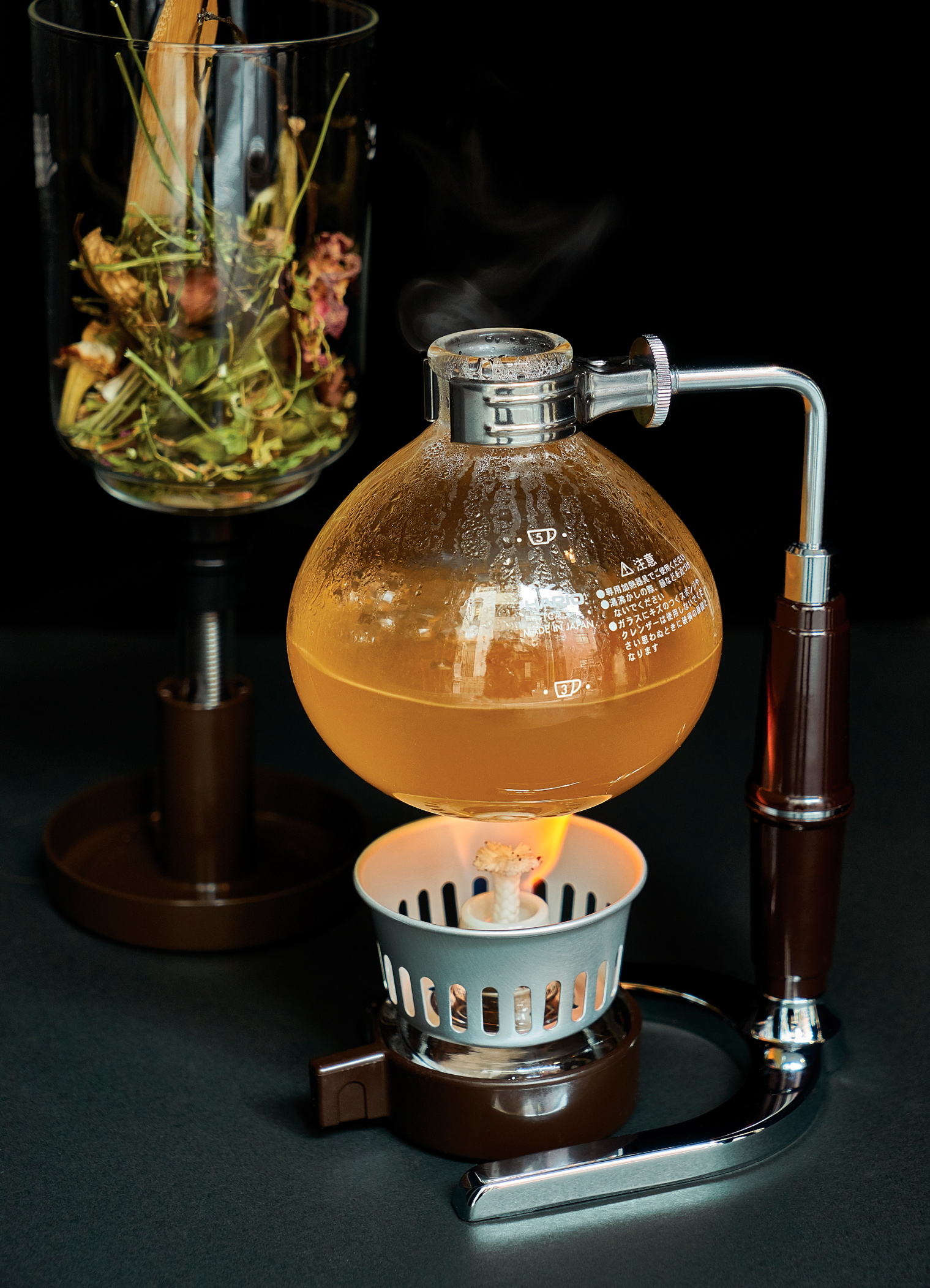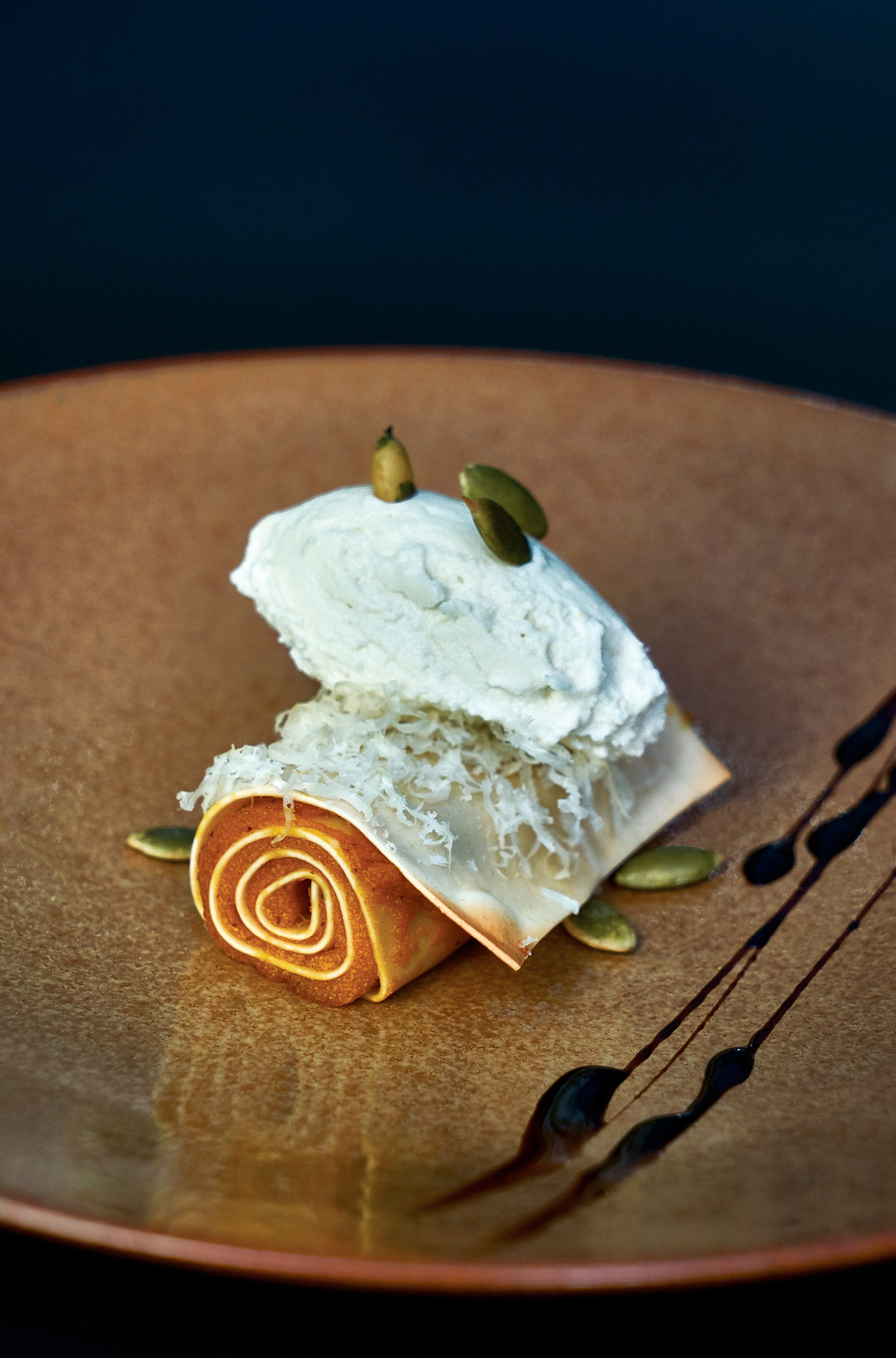


ELEGANCE
HEART
Toshifumi Nakahigashi expresses an unhindered joy and love for Italy, declaring that his heart might be in Kyoto, the city of his birth, but his soul is most definitely in Italy. He went to live there at eighteen, first to learn the language and then to find a job. He traveled the country, dining at a range of restaurants to learn about and understand Italian cuisine. He established a deeply rewarding and fascinating life in Italy, working at many top Michelin-starred restaurants, including Arnolfo Ristorante outside Siena. Nakahigashi has a deep understanding of Italian technique, and his refined and elevated tastes and perspective make for an enchanting dining experience at Erba da Nakahigashi.
An elegant jewel of a restaurant, Erba da Nakahigashi is fresh, smart, refined, and thoroughly stylish with tones of dark gray and black and a series of cascading lights hovering over the counter. Thirty-five-year-old Nakahigashi hails from generations of lauded chefs; his grandmother was a pioneering chef who specialized in mountain vegetables, and his father is the famous two-star Michelin chef Sojiki Nakahigashi, a master of kaiseki cuisine (haute cuisine).
Speaking with Nakahigashi in Italian and spending time with him is a joyful experience because he is so joyful himself. He smiles often and intersperses his spoken Italian with colloquialisms; he learned the language well and speaks with fondness of the friends he made in Italy. Recalling his first mentor, chef Gaetano Trovato of Arnolfo Ristorante, his great affection and regard is palpable. Nakahigashi also mentions a year working at Plaza Athenée in Paris as a supremely instructive experience, yet not as transformative or viscerally nourishing as his time in Italy.
As he reminisces about the food, friends, farmers, and architecture he left behind in Tuscany, Nakahigashi wistfully acknowledges that he dreams of Italy and misses it daily. He is also attached to Japan, however, and finds that the two countries are culinarily strikingly similar. Nakahigashi touches upon his deep-rooted respect for ingredients and terroir as we drive to meet the farmer who provides the roses for his squab dish. One of his mantras—using few ingredients and preparing them in a complex fashion equals respect for the ingredients—is a philosophy he sees as foundational to Italian and Japanese food.
The comparable umami that is present in both cuisines makes an Italian restaurant in Japan the most natural of phenomena, he says. As I savor a spoonful of umami-rich gorgonzola mousse, I nod in agreement and make a reservation to return.

What made you decide to become an Italian chef?
When I was thirteen, I ate spaghetti al pomodoro near my house in Kyoto at a restaurant called Casa Bianca. It amazed me. It was so tasty, but simple with minimal ingredients. The perfume of the olive oil, the way it was cooked, was perfect, as was the Parmigiano-Reggiano. From that moment, I wanted to learn everything about Italy. I liked and appreciated Kyoto cuisine but thought it was very complicated. I somehow thought Italian food would be easier to make well, but it is not.
I always knew I would open a restaurant in Japan, and I knew I had to plan how to do this. I wanted to learn about traditional Italian cuisine before Michelin-starred food. I wanted to start in Tuscany, where there is a lot of respect for ingredients. The first dish I had when I arrived was rabbit liver with shallots. The second was pici [thick hand-rolled pasta, similar to spaghetti] with pork ragù. I understood that this traditional food was being prepared in a very modern and elegant way. It touched my soul. I loved it!
Tell me your thoughts about cooking.
Cooking is interesting to me—how all the ingredients change according to each cuisine. In Italian cuisine, if the ingredient is great, the dish can be great as that is the essence. I come from a family of chefs. When a chef like me brings more complicated technique and inspiration from my own personal life, a dish becomes more interesting. From the age of eighteen, I have had a lot of the spirit of Italy in me. I think Italian food is about tasting the essence of the ingredient. I put my life into it.
The workmanship can certainly be complicated, but the result on the plate must not, because if the flavors are too complicated, one does not taste all the ingredients or respect them. The fragrance of an ingredient, for example, should be distinguishable. Too many ingredients mixed together and the chef runs the risk of making it too hard to perceive or distinguish them, and the dish fails. For example, I would never pair uni with beef, but here in Japan, they do it.
Tell me a bit about what you thought of Italy.
It was easy to be with so many nice Italian people. Friends would invite me to their homes, where I would taste their mother’s food. Even the architecture was very interesting. Some friends’ families had country homes with farms and animals, like rabbits. I worked at all Michelin-starred restaurants, where there were staff from all over Italy and even from Japan. I didn’t miss Japan too much.
Do you think there are commonalities between Japanese and Italian cuisine?
Yes. Dashi and spaghetti al pomodoro have the same umami. It’s the glutamic acid, one of the elements of umami, in the tomato sauce, like kombu in Japanese food. There is also glutamic acid in Japanese dashi and in Parmigiano-Reggiano. All of these are similar. And the idea of simplicity and deep respect for ingredients is in both cultures. I think bread, extra-virgin olive oil, and sea salt in Italy is like rice and tsukemono [preserved vegetables] here.
For you, what does it mean to be Japanese?
It means to be malleable. Aspects of our culture came from China, Korea, Thailand, and other countries. Many cultural elements arrive here, even from the United States. We are always trying to improve our culture and our cooking. We like to adapt and change things, even improve them sometimes. Yes, past generations used to be much more rigid. For example, five hundred years ago, there was no frying in Japan, until it came via Portugal. If we didn’t learn how to fry from the Portuguese, we wouldn’t have tempura.
Is eating spaghetti al pomodoro your earliest first food memory?
No, when I was four or five years old, I remember eating tochi mochi [sweet rice cake] made of a chestnutlike nut found in the mountains outside Kyoto. The cook at my grandparent’s restaurant handed it to me—it was nice and fresh and soft. I loved it.
What fuels your creativity in the kitchen?
I take inspiration from the garden of the mountains—any mountains really. I love the air and all the seasons. The seasons were important in Tuscany, too. We went often to the vineyards, and in Lago di Garda, I went to the mountains and we picked wild herbs. There was also a garden behind the restaurant. I also take inspiration from Picasso and the ceramicist Kitaoji Rosanjin, and the painter Jakuchu, who painted three hundred years ago.
What is your favorite word?
I have a phrase that I like:
Jinseide okorukotoha subete sarano uede okoru.
“If it happens in life, it happens on the plate.”
What is one of your favorite films?
I will give you two: Big Night and Cinema Paradiso. Big Night is about two brothers who wanted to defend the traditions of Italian food, I like that. I like Cinema Paradiso for how it shows the passage of time, the history of Italy, and how things change.



PUMPKIN LASAGNE

The remembrance of the beginning of autumn is evoked with the sweetness of the humble pumpkin and the perfume of the elegant Gorgonzola.
SERVES 6 TO 12
PUMPKIN PUREE
1 small pumpkin (7 ounces), cut in half and seeded
1 clove garlic, peeled
1 rosemary sprig
¾ cup heavy cream
7 tablespoons unsalted butter
PASTA
1 cup plus 2 tablespoons Italian 00 flour, such as Antimo Caputo brand
2 eggs
GORGONZOLA MOUSSE
2 ounces Gorgonzola piccante (or aged Gorgonzola)
1½ tablespoons heavy cream
Butter, for greasing the pan
4 tablespoons grated Parmigiano-Reggiano
Hulled pumpkin seeds, for garnish
Preheat the oven to 325°F.
To make the pumpkin puree, place the pumpkin, garlic, and rosemary on a large sheet of aluminum foil. Wrap the foil tightly to seal and place on a baking sheet. Bake for about 1 hour, until the pumpkin is soft and a toothpick inserted in the center comes out clean. Unwrap and let cool to room temperature, then remove the flesh with a spoon and discard the skin, rosemary, and garlic.
Press the pumpkin through a medium-mesh sieve or chinois into a large bowl.
Place the cream and butter in a saucepan over low heat, stirring occasionally, until the butter has melted. Pour into the pumpkin puree and stir until combined.
To make the pasta, combine the flour and eggs in another bowl, mixing together with your hands and then kneading until a smooth dough forms, about 5 minutes. Gather into a ball and let the dough rest for about 20 minutes.
To make the Gorgonzola mousse, combine the Gorgonzola and heavy cream in a small sauce pan and cook over medium-low heat for about 5 minutes, stirring, until creamy. Pour the mousse into a container and refrigerate for 10 minutes, until thickened. Keep chilled until serving.
Divide the dough into four sections and form each into a rectangle about ½ inch thick. Using a pasta machine, roll out one piece of dough, starting at the largest setting and working your way down until it is 1⁄16 inch thick, or about the second smallest setting. Cut the dough into an 8 by 14-inch sheet. Cover with a kitchen towel and repeat with the remaining dough.
Prepare an ice bath. Bring a large pot of salted water to a boil. Add two pasta sheets and cook for about 1 minute, then drain and put in the ice bath for a few seconds to cool. Remove the pasta sheets from the ice bath with a spider skimmer and spread out on a work surface until dry, or place in the refrigerator covered in towels until ready to assemble. Repeat with the remaining pasta.
Preheat the oven to 400°F. Lightly grease a baking sheet with butter.
Place a pasta sheet on a clean work surface. With a tablespoon, spread some of the pumpkin puree over a pasta sheet in a thin layer. With the long side facing you, roll the pasta into a log shape. Cut it into thirds. Repeat with the remaining three sheets of pasta.
Place the rolled lasagne pieces in the prepared baking sheet and bake for about 10 minutes until lightly browned.
Place one or two lasagne rolls in the center of the serving plates and sprinkle with the Parmigiano-Reggiano. With two spoons, shape the mousse into two quenelles, or oval spoonfuls, and place on top of the lasagna rolls. Sprinkle with the pumpkin seeds and serve right away.